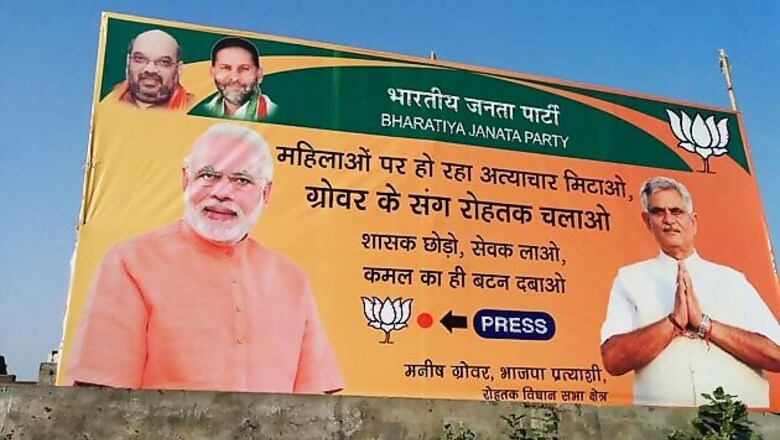
views
Rohtak: The Bharatiya Janata Party (BJP) claims that its journey to forming the government in Haryana in Chandigarh starts at Rohtak. The BJP state office is also located in Rohtak, not in the state capital Chandigarh.
The BJP had been a marginal player in the state politics till it swept the Lok Sabha elections in May 2014. The Narendra Modi wave shook the ruling Congress and the main opposition Indian National Lok Dal (INLD) as the BJP occupied the centre position in state politics overnight.
What explains the sudden rise of the BJP in Haryana, which had been a two-party state for decades?
The answer lies in the state's caste politics and the changed caste equations in the last two years.
The BJP has been very lucky. As someone says BJP is at the right place at the right time. Without playing any major role in the state politics or participating in any big movement, the party seems to have overtaken the Congress and the INLD, which ruled the state by turn in the last 30 years.
Till Narendra Modi was anointed as the Prime Ministerial candidate of the BJP, the saffron party was not taken seriously by the voters in Haryana. Even though one of BJP's top leaders Sushma Swaraj is from Haryana, she always won Lok Sabha elections from outside her home state. It explains the condition of the BJP before the recent Lok Sabha elections and the Modi magic in the state.
For a long time, the voters in Haryana were divided into two major blocks. The dominant caste, Jats whose population is almost 25% of the total population in the state has been traditionally with the Chautalas led INLD and non Jat castes like the Brahmins, Baniyas, Dalits and the Punjabis had been with the Congress.
According to local political analysts, Chief Minister Bhupinder Singh Hooda unintentionally allowed the rise of BJP in Haryana. In his eagerness to take away the Jat votes from the INLD, Hooda, himself a Jat, overplayed the Jat card, angering the traditional Congress vote banks like the Brahmins, Baniyas, Dalits and the Punjabis. Hooda had underestimated the BJP and was under the impression that it would never pose a serious challenge to the Congress or the INLD in Haryana.
Explaining this local journalist Deepak Bhardwaj said, "Hooda thought that the non-Jat votes will always remain with the Congress as they can't vote for the INLD. He took them for granted and started the Jat appeasement with the sole intention of destroying the INLD. But, the Congress is now left with neither."
According to some analysts the non-Jat voters had backed the BJP in full strength in the recent Lok Sabha election and the BJP established lead in 52 of the total 90 assembly seats in the state. In the current Assembly election, the Jats are expected to back the Chautalas' INLD and the non-Jats are likely to back the BJP in a big way. It leaves the ruling Congress with no dependable and sizable vote bank. It is a case of Hooda's strategy backfiring.
The BJP is hoping that it will cross the halfway mark of 45 seats on its own. It is also planning to approach the HJC of Kuldip Bishnoi and the independents in case of a hung assembly with the BJP emerging as as the single largest party.
In the 2009 assembly election, the BJP, which decided to go it alone, saw its votes declining from 10.4% in 2005 to 9% in 2009. The best performance by the BJP was in 1987, when it won 16 seats in alliance with the INLD.
After going down to just two seats in 1991, the BJP's next best show was 11 seats in 1996. In the 2000 assembly election, the BJP had six MLAs, which went down to just two in 2005 elections and marginally climbed to four in 2009.
If the BJP wins Haryana on its own or at least wins more than 35 seats, it will certainly be a huge achievement for a party, not taken seriously just two years ago. The credit of its rise should go to the mass appeal of the Prime Minister Narendra Modi and the Hooda's wrong caste calculations and strategies.



















Comments
0 comment